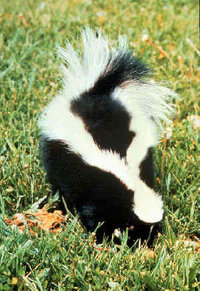Skunk
Skunks are medium-sized mammals with black-and-white-fur belonging to the family Mephitidae and the order Carnivora. more...
There are 11 species of skunks, which are divided into four genera: Mephitis (hooded and striped skunks, two species), Spilogale (spotted skunks, two species), Mydaus (stink badgers, two species), and Conepatus (hog-nosed skunks, five species). The two skunk species in the Mydaus genus inhabit Indonesia and the Philippines; all other skunks inhabit the Americas from Canada to central South America.
Skunks are sometimes called polecats because of their visual similarity to the European polecat (Mustela putorius), a member of the Mustelidae family.
Description
Skunk species vary in size from about 40 cm to 70 cm and in weight from about 0.5 kg (the spotted skunks) to 4.5 kg (the hog-nosed skunks) They have a moderately elongated body with reasonably short, well-muscled legs, and long front claws for digging.
Although the most common fur color is black and white, some skunks are brown or gray, and a few are cream-colored. All skunks are striped, however, even from birth. They may have a single thick stripe across back and tail, two thinner stripes, or a series of white spots and broken stripes (in the case of the spotted skunk). Some also have stripes on their legs.
Behavior
Skunks are nocturnal. They are best-known for their ability to spray a foul-smelling and sticky fluid as a defense against predators; this secretion comes from the anal scent glands. The odor of the fluid is strong enough to ward off bears and other potential attackers. The odor can be difficult to remove from a human's clothing.
Skunks are solitary animals when not breeding, but may gather together to keep warm in communal dens in the coldest part of their range. During the day they shelter in burrows that they dig with their powerful front claws, or in other man-made or natural hollows as the opportunity arises. Both sexes occupy overlapping home ranges through the greater part of the year; typically 2 to 4 km² for females, up to 20 km² for males.
Unlike the fictional "Flower" in the movie Bambi, real skunks do not hibernate in the winter. However they do remain generally inactive and feed rarely. They often overwinter in a huddle of one male and multiple (as many as twelve) females. The same winter den will be repeatedly re-used.
Feeding
Skunks are omnivorous, eating both plant and animal material but mostly meat. They eat invertebrates (insects and their larvae, found by digging, and worms) as well as small vertebrate (rodents, lizards, salamanders, frogs, snakes, birds and eggs). In the wild, skunks forage for food, and in settled areas also seek human garbage.
Read more at Wikipedia.org



